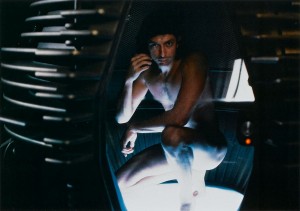The Fly ***** (1986, Jeff Goldblum, Geena Davis, John Getz) – Classic Movie Review 194

‘I don’t think The Fly is mainstream,’ claims David Cronenberg. ‘A mainstream movie is one that isn’t going to rattle too many cages. No horror film is truly mainstream.’
Point taken, but nevertheless, when he remade the 1958 horror classic The Fly in 1986, Cronenberg was indeed making his first mainstream movie, working in his native Canada for Mel Brooks and Brooksfilms and for 20th Century Fox.
Inheriting a script by Charles Edward Pogue that he gave a complete makeover to, Cronenberg turns the old technofear horror movie into an AIDS-era doomed love story and a science-gone-mad tale, exploring themes of the challenges of sickness and ageing. Also, crucially, Franz Kafka’s 1912 novel Metamorphosis, in which a man wakes up to find he’s been transformed into a giant insect, is accessed.
In the latter stages of the film, Cronenberg concentrates on the way his protagonist deals with his disease, and is obsessed with the details of his deterioration. The atypical hero starts be being remarkably sexy and muscular, quite unlike your usual nerdy, weedy boffins of fiction. He is going to be punished for his arrogance and vanity.
Despite not being first choice, Jeff Goldblum is ideally cast in an offbeat hero role like this. He responds by giving a magnetic, totally engrossing performance as Doctor Seth Brundle, the brilliant, obsessive, eccentric scientist who is going a bit nuts researching the field of matter transportation. A feisty and appealing Geena Davis co-stars as Veronica Quaife, the kindly investigative reporter whom Brundle tries to romance by offering her a scoop on his teleportation experiments.
There have been gremlins in the works but Brundle finds he can successfully teleport a living creature, so it’s safe for him to show he can transport himself. He puts himself into a gene transporter. As everyone must know by now, a house fly enters the transmission chamber with him and his genes get mixed up with the fly’s. Brundle finds everything’s gone wrong (well, only one thing actually) and begins to turn into a fly. Creepy, huh?
And now the really scary thing is that Quaife finds she can’t help him.
‘Be afraid, Be very afraid,’ the posters memorably boasted to get you into the cinema. Fear there is, but it’s mainly body horror revulsion that Cronenberg is after, and he ensures there’s enough stomach-churning stuff in the final third of the movie to deliver that in bucketloads. Its gleefully executed excesses earned the movie an 18 certificate back in the day, though it certainly wouldn’t now, I’m sure.
For all its repulsive body horror, this is an electrifying, sophisticated horror film, extremely stylishly made by Cronenberg who doesn’t miss any of his chances in one of his best movies. He delivers a beautifully polished-looking movie with a sleek and shiny surface, a work of rare craftsmanship, unusually so for a horror movie.
At the same time, The Fly provides a full measure of scares and disgusting moments to satisfy the die-hard horror fans, while adding fully fleshed-out characters and useful hints of cynical black humour to the provocative mix that started with George Langelaan’s original story. It’s very careful not to betray that, or the 1958 film either, merely building on both, as you’d expect with a literate and cine-literate director like Cronenberg.
The terrific makeup won an Oscar for Chris Walas and Stephan Dupuis. These as well as Howard Shore’s score, Mark Irwin’s cinematography, Carol Spier’s production designs and Rolf Harvey’s art direction provide the gloss I was talking about.
Following a first meeting with Martin Scorsese, who said he looked like a plastic surgeon, Cronenberg cast himself in a cameo as a gynaecologist who delivers a maggot baby.
Michael Keaton turned down the star role. Tim Burton was a possible director.
An opera version was staged in 2008, directed by Cronenberg with music by Shore.
© Derek Winnert 2013 Classic Movie Review 194
Check out more reviews on http://derekwinnert.com



